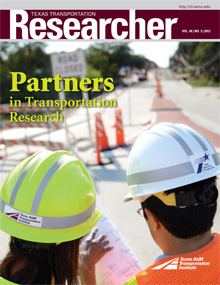Making the Most of Main Street Texas
Traffic congestion is as familiar as bluebonnets on the roadside for anyone who’s traveled I-35 in the last 20 years.
The interstate route — which in Texas stretches south from the Red River all the way to the Rio Grande at Laredo — has carried commerce and commuters across the Lone Star State for nearly 150 years. Before the modern highway was christened I-35 in 1959, much of it was known as the Chisholm Trail.
Once crowded with cattle in long drives north to Kansas, today’s I-35 has a similar reputation for being tightly packed — only now it’s bumpers, not bovines, causing the slowdown. In an innovative approach to improving the roadway’s capacity, the Texas Department of Transportation (TxDOT) created MY 35, a citizen-driven effort to expand a 96-mile stretch from Hillsboro to Salado of I-35 in the Waco District. At an estimated total cost of $2.5 billion, the overall effort is made up of 17 smaller construction projects and targeted for completion in 2017.
TxDOT Teams with TTI

A project of this size is a huge undertaking, and not just when it comes to coordinating the construction itself. TxDOT is reconstructing nearly 100 miles of roadway in a relatively short amount of time, and that affects hundreds of thousands of citizens living nearby, tens of thousands of businesses, and millions of travelers over the life of the project.
TxDOT engaged the Texas A&M Transportation Institute (TTI) to provide independent technical support for the effort. One way TTI is helping is by providing mobility coordinators to keep citizen groups and businesses informed and lessen any negative impact of construction.
For example, TxDOT is converting many two-way access roads along the interstate to one way to improve safety. To business owners situated beside I-35, the change can seem threatening because, in the short term at least, it potentially changes customer access to their stores.
“Our job is to talk through the entire process with the business owner,” says TTI Research Engineer Jim Dale, lead mobility coordinator on the project. “We let them know we understand their concerns and help them see the longer-term benefits of the changes.”
Helping TxDOT get the word out is one of two major jobs for TTI on the project. The Institute developed a communications plan for the department and has done everything from designing flyers, truck stop signs and email alerts to organizing public meetings and writing, editing and distributing My 35 Central Texas News, a monthly newsletter aimed at keeping interested parties informed.
“Whatever means we use, our main goal is to get information into the hands of citizens and business owners so they can make the best decisions possible for their travel needs,” says Dale. “And very soon we’ll be getting the word out in a whole new way.”
Getting the Word Out in Real Time

What Dale is referring to is a first-of-its-kind traveler-information system developed by TTI for the I-35 project. The system integrates several methods for capturing data, forecasts congestion along the construction route, and provides that information to everyone who wants it. The system, currently being refined, is a primary example of how TxDOT and TTI are working together to improve transportation in Texas.
“The purpose of the system is two-fold,” explains TTI Research Scientist Bob Brydia, principal investigator on the traveler-information project. “First, it’ll give reliable traffic forecasts for I-35 travelers while the expansion project is under construction. Second, after construction is finished, it’ll form the basis for a comprehensive traffic management system for TxDOT’s Waco District.”
The traveler-information system is similar in concept to modern traffic management systems used in urban areas. The unique aspect is combining construction data and corridor travel data for a long interstate highway passing through rural and urban areas. Put simply, the system marries three data-gathering methods together to create reliable forecasts for travelers:
- Bluetooth® technology — Travelers’ devices (e.g., cell phones, laptops and the GPS systems in newer cars) are anonymously pinged at point A and point B, giving a reliable estimate of travel time between the points.
- Wavetronix sensors — Placed strategically along the corridor at 17 points of high traffic interaction, such as where a state highway crosses I-35, these sensors capture traffic volume.
- End-of-queue warning systems — Radar detectors mounted in orange barrels around work zones measure speeds of approaching vehicles as they near the work zone, and patterns of slowing traffic (indicating a backup in traffic flow) are noted.
TTI has developed computer algorithms to integrate this information together to create reliable traffic forecasts, which are then passed on to travelers. Once the system is fully up and running, travelers will be able to access reliable forecasts via the Internet of what traffic on I-35 in Waco will be in an hour, before they ever leave Hillsboro, some 40 miles away.
It sounds simple enough in theory, but gathering and analyzing the data and creating reliable forecasts are incredibly complex tasks. And different information systems have to talk effectively with one another to make sure the information stays accurate and useful by the time it reaches travelers.
“From our perspective, a real success story of this project is how effectively we’ve been able to interface with TxDOT’s LoneStar traffic management system,” says Brydia. “Using their data protocols, we feed our information to them, and that helps drive the messages you see on the portable changeable message signs [PCMSs].” PCMSs display traffic forecasts along the roadway.
While congestion can be inconvenient for travelers, it can also be costly — in very real terms — for big business. Knowing where work zones are, what lanes will be closed, and when to expect slower travel is vital for companies like Walmart and H-E-B. They rely on I-35 to get their goods via truck from major distribution hubs to their brick-and-mortar stores. When you’re talking perishables, traffic backups can mean the difference between fresh and spoiled milk — and that can translate into lost revenue for the company and higher prices for consumers.
Similarly, with better information on hand, emergency management services personnel can get to the scene of an accident sooner. The life-saving potential there really needs no further explanation.
“Right now, the main way for alerting travelers is via PCMSs and daily email alerts,” explains Brydia. “Very soon we hope to take advantage of social media, including Twitter, and supply real-time information to TxDOT’s My35.org website in the form of a dynamic traffic map.”
Jodi Wheatley, Waco District’s information specialist for the project, acknowledges that without TTI’s help, the I-35 expansion effort would have been much tougher.
“Reconstructing almost 100 miles of interstate is a massive job for the department, and at the end of the day we at TxDOT want to be as responsive and helpful as we can to our fellow Texans,” Wheatley says. “Because of the scope of the project, that would be much more difficult without TTI’s logistical support and technical know-how. Maybe even impossible.”
